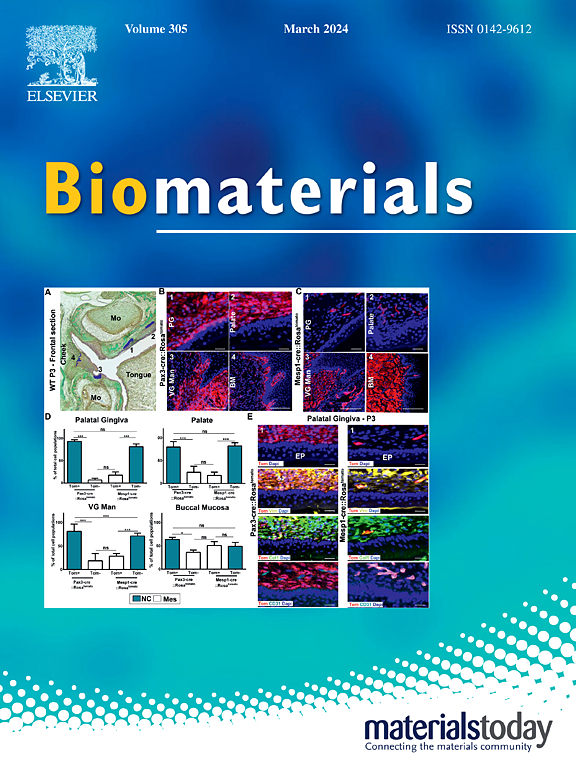皮质内微电极阵列的神经炎症反应的多组学空间分辨分析
IF 12.8
1区 医学
Q1 ENGINEERING, BIOMEDICAL
引用次数: 0
摘要
皮层内微电极阵列(MEAs)是一种植入大脑皮层的装置,具有记录或刺激神经元活动的能力。不幸的是,mea往往在慢性时间点失效,限制了它们的临床应用。慢性衰竭在很大程度上归因于大脑的神经炎症反应。直到最近,大多数关于MEAs的神经炎症反应的理解都是通过对少量蛋白质的免疫组织化学分析来了解的。最近,基因表达研究已经对数千个导致神经炎症的mRNA分子进行了测序,但很少有研究进行了大规模的蛋白质组学分析。为了进一步了解所涉及的分子机制,我们先前使用空间蛋白质组学平台研究了62种蛋白质在MEA植入位点180 μm内的活性。在本研究中,我们首次将大规模基因组学和蛋白质组学应用于MEAs,因为我们评估了整个蛋白质编码小鼠转录组和我们的62蛋白蛋白质组学面板的变化。我们进一步研究了靠近MEA的三个不同区域内神经炎症反应的空间分布:距离植入部位0-90 μm, 90-180 μm和180-270 μm。我们的分析直接比较了基因和蛋白质的表达,并强调了基于与植入部位近端距离的分割的必要性。我们还确定了与免疫细胞激活、神经变性和代谢相关的关键途径,这些途径可能导致MEA失败,并可能在未来的研究中有针对性地提高MEA的性能。本文章由计算机程序翻译,如有差异,请以英文原文为准。
Multi-omic spatially resolved analysis of the neuroinflammatory response to intracortical microelectrode arrays
Intracortical microelectrode arrays (MEAs) are devices implanted into the brain's cortex with the ability to record or stimulate neuronal activity. Unfortunately, MEAs tend to fail over chronic time points, limiting their clinical utility. Chronic failure has largely been attributed to the brain's neuroinflammatory response. Until recently, most of what was understood about the neuroinflammatory response to MEAs was learned through immunohistochemical analysis of small numbers of proteins. More recently, gene expression studies have sequenced thousands of mRNA molecules that contribute to neuroinflammation, but few studies have performed large-scale proteomic analyses. To expand the knowledge of molecular mechanisms involved, we have previously investigated the activity of 62 proteins within 180 μm of the MEA implant site using a spatial proteomic platform. In the present study, we are the first to apply large-scale genomics and proteomics to MEAs, as we evaluate changes in both the whole protein-encoding mouse transcriptome and our 62-protein proteomic panel. We further examine the spatial distribution of the neuroinflammatory response within three distinct domains adjacent to the MEA: 0–90 μm, 90–180 μm, and 180–270 μm from the implant site. Our analysis directly compares the gene and protein expression and highlights the need for segmentation based on proximal distance from the implant site. We also identify key pathways associated with immune cell activation, neurodegeneration, and metabolism that likely contribute to MEA failure and could be targeted to improve MEA performance in future studies.
求助全文
通过发布文献求助,成功后即可免费获取论文全文。
去求助
来源期刊

Biomaterials
工程技术-材料科学:生物材料
CiteScore
26.00
自引率
2.90%
发文量
565
审稿时长
46 days
期刊介绍:
Biomaterials is an international journal covering the science and clinical application of biomaterials. A biomaterial is now defined as a substance that has been engineered to take a form which, alone or as part of a complex system, is used to direct, by control of interactions with components of living systems, the course of any therapeutic or diagnostic procedure. It is the aim of the journal to provide a peer-reviewed forum for the publication of original papers and authoritative review and opinion papers dealing with the most important issues facing the use of biomaterials in clinical practice. The scope of the journal covers the wide range of physical, biological and chemical sciences that underpin the design of biomaterials and the clinical disciplines in which they are used. These sciences include polymer synthesis and characterization, drug and gene vector design, the biology of the host response, immunology and toxicology and self assembly at the nanoscale. Clinical applications include the therapies of medical technology and regenerative medicine in all clinical disciplines, and diagnostic systems that reply on innovative contrast and sensing agents. The journal is relevant to areas such as cancer diagnosis and therapy, implantable devices, drug delivery systems, gene vectors, bionanotechnology and tissue engineering.
 求助内容:
求助内容: 应助结果提醒方式:
应助结果提醒方式:


